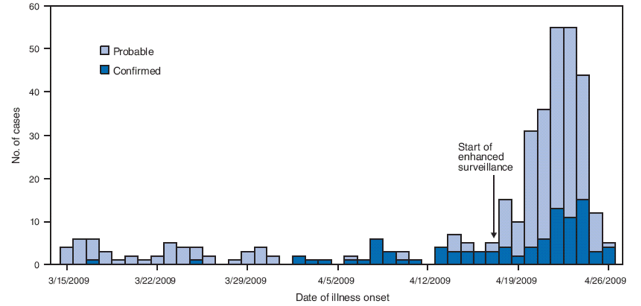.
(CDC) – In March and early April 2009, Mexico experienced outbreaks of respiratory illness and increased reports of patients with influenza-like illness (ILI) in several areas of the country. On April 12, the General Directorate of Epidemiology (DGE) reported an outbreak of ILI in a small community [La Gloria – Oui] in the state of Veracruz to the Pan American Health Organization (PAHO).
Of 1,069 patients with suspected and probable cases for whom information was available, 755 were hospitalized, and the remaining 314 were examined in outpatient settings or emergency departments. Suspected or probable cases were reported from all 31 states and from the Federal District of Mexico. The four areas with the most cases were Federal District (213 cases), Guanajuato (141), Aguascalientes (93), and Durango (77). In other states, the number of suspected or probable cases ranged from two to 46. Suspected and probable cases were identified in all age groups. Mexico routinely monitors seasonal influenza in a network of outpatient facilities throughout the country. Fifty-one influenza A positive specimens from six states were collected during January 4–March 11 in this surveillance network. All of these specimens tested negative for S-OIV at CDC.

FIGURE. Number of confirmed (N = 97) and probable (N = 260)* cases of swine-origin influenza A (H1N1) virus (S-OIV) infection, by date of illness onset --- Mexico, March 15--April 26, 2009
CDC continues to issue and update interim guidance daily in response to the rapidly evolving situation. Early this morning, CDC provided interim guidance on school closures. Supplies from CDC’s Division of the Strategic National Stockpile (SNS) are being sent to all 50 states and U.S. territories to help them respond to the outbreak.
"But I will not let myself be reduced to silence."




